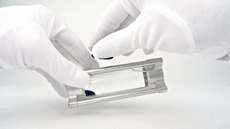Ferrofluids
Claimed by Brandon Chen
Ferrofluids (the combination of ferromagnetic and fluid) are defined as liquid which, when placed within a magnetic field, experience strong magnetizations which can result in incredibly versatile shapes and forms. This phenomenon stems from the dispersal of ferrimagnetic particles (often hematite or other particles containing iron) which help create the composition of the fluid. Typically, these particles are suspended water or another organic solvent.

Significance
Applications

There are a wide array of potential applications for ferrofluids ranging from electronics, to art, to optical engineering, to propulsion. In optics, researchers are attempting to adapt ferrofluids for use in telescopes: the idea is to have a mirror which has capabilities of altering its shape. They are currently used in loudspeakers as a way to cool the voice coil and thus mitigate shifting in the cone. In addition, there are applications in electronic devices; these magnetic fluids can be utilized to seal spinning shafts in hard discs by creating a wall through which minimal debris and other particles can pass. There also exists medical applications through magnetic drug targeting.
The idea behind this it so delivery the drug into the patient's body while its encapsulated by a ferrofluid, then direct the drug into its optimal delivery area using an external magnetic field, and finally release the drug by turning off the field. Lastly, there are potential adaptations in the field of spacecraft propulsion. One of the hallmark effects of ferrofluids are the thin spikes which emerge in the presence of a magnetic field. These spikes, when sharpened to a specific thickness, can emit jets. This effect could be taken advantage of as a way of creating thrust in small objects.
A Mathematical Model
The following equations can be used to mathematically model the behavior of a ferrofluid when under the influence of an external magnetic field. These equations stem from a combination of the magnetizaton equation, magnetostatic equations, and the Navier-Stokes equations.
File:2d04cf43fba94293b33ae647f0c7663b.png.png
History
Non-Newtonian, as well as Newtonian, fluids were first described by scientist Isaac Newton during the 1600s. The idea came when Newton wanted to know how much force had to be applied to a liquid for the liquid to reach a desired flow. Upon working with many different types of fluids, Newton came to the conclusion that some liquids behaved in a very similar manner(Newtonian fluids), while others behaved in a very extraordinary and different manner(non-Newtonian fluids) which differed from his prediction that all liquids behaved homogeneously.
Examples of Non-Newtonian Fluids
- Ketchup
- Toothpaste
- Starch mixed with water
- Shampoo
- Blood
- Custard
- Paint
See also
Further reading
- Tropea, Cameron; Yarin, Alexander L.; Foss, John F. (2007). Springer handbook of experimental fluid mechanics.
- Chhabra, R.P. (2006). Bubbles, Drops, and Particles In Non-Newtonian Fluids. (2nd ed.). Hoboken: Taylor & Francis Ltd.
- Fridtjov Irgens(2014). Rheology and Non-Newtonian Fluids.
External links
References
- Tropea, Cameron; Yarin, Alexander L.; Foss, John F. (2007). Springer handbook of experimental fluid mechanics.
- Chhabra, R.P. (2006). Bubbles, Drops, and Particles In Non-Newtonian Fluids. (2nd ed.). Hoboken: Taylor & Francis Ltd.
- Fridtjov Irgens(2014). Rheology and Non-Newtonian Fluids.
- "What Is a Non-Newtonian Fluid?" General Chemistry Online: FAQ: Liquids:. N.p., n.d. Web. 03 Dec. 2015.
- Io9. "Non-Newtonian Fluids: For When You Want a Liquid That's Also a Solid." Io9.com. N.p., 20 Dec. 2010. Web.